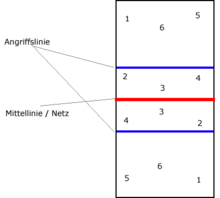Player (volleyball)
The setter , or colloquially Steller , " distributor " Passeur or Ballumlenker called, has in volleyball the task of coordinating the attacks of their own team and to use the attacker accordingly. As the name suggests, its job is to pass the ball to the attackers . But this is not the sole responsibility of the player. Furthermore, the player makes the most important decisions for the next attack by his own team, who will attack the ball and what kind of ball will be played.
position
As a rule, the feed takes place from position 2 or 2–3. With the runner system , the player always takes this position immediately after receiving the ball in order to be able to pass it quickly. An attempt is made to prevent the player from accepting the first ball, as otherwise he is no longer allowed to pass and another player has to take over the task of the player for this ball. When accepting a serve, the player is usually excluded from acceptance if he is at the back, but must then take position 1 when defending against the attack.
In many leisure and youth teams, the standard position is 3, since the team must first be taught the complex runner system and only makes sense from a certain team strength.
Function and tasks
The main task of the player is to initiate the attack of his own team by passing the ball to an attacker. He also has basic tasks such as defending and serving. In higher-class teams, the player can play almost any other player (except Libero). He can play the ball to the main attacker (outside), to the middle block (middle) or to the diagonal attacker (overhead). In addition, the player has the option of actively involving players from the back field in the attack. A so-called "rear area attack", usually via position 1, can be used to carry out a surprising attack from behind. The attackers have to jump behind the three-meter zone.
Tactical options
The attack possibilities in volleyball are very variable and numerous. Starting with the simple ball on the outside attacker on the 4, you can play faster balls in the middle, for example promoted or shot. An attack via the diagonal attacker is also an often seen action in professional volleyball. In addition, attacks can also be combined and squadrons set up in which several attackers approach at the same time and thus bind the block in order to be able to attack without obstacles.
literature
- International rules of volleyball, Hofmann-Verlag Schorndorf, ISBN 9783778037331
- Right volleyball (paperback), BLV Verlagsgesellschaft mbH, ISBN 9783405161392
- The volleyball coach. Teaching practice for trainers and trainers (paperback), Vsd Volleyball Service, ISBN 9783405133771
